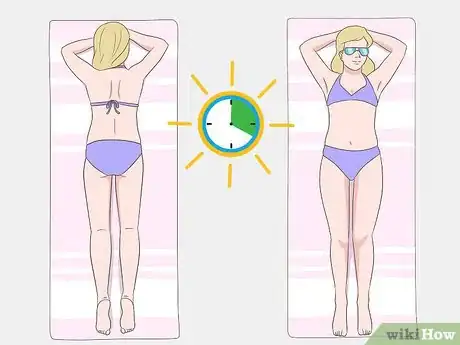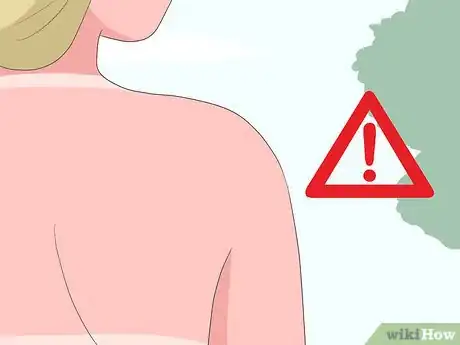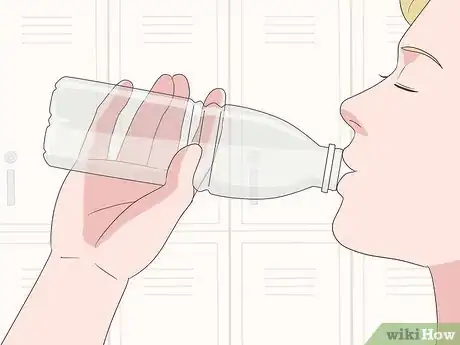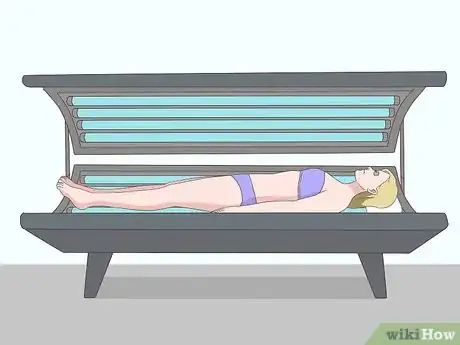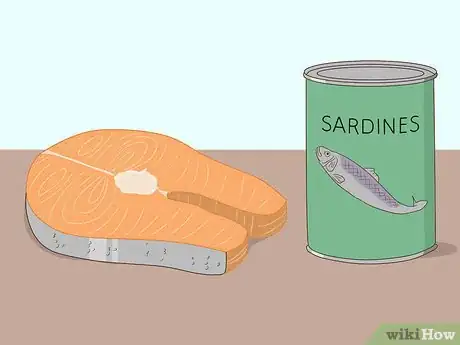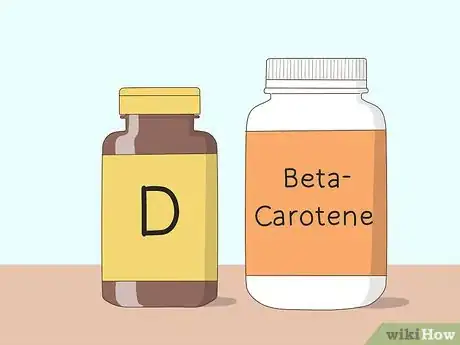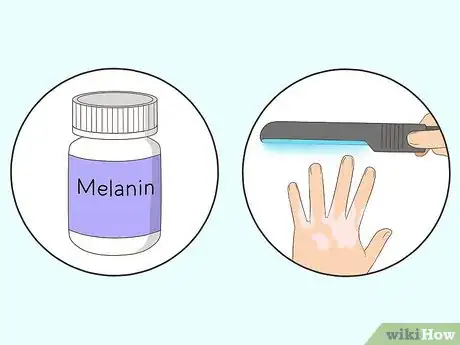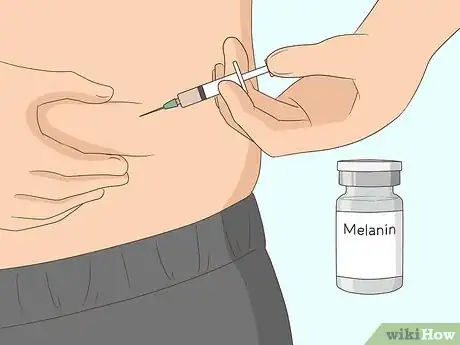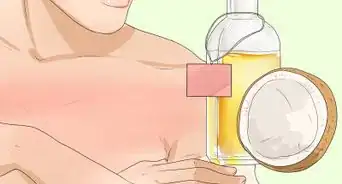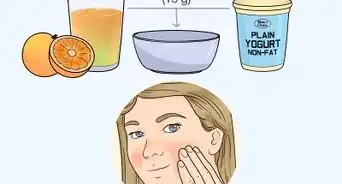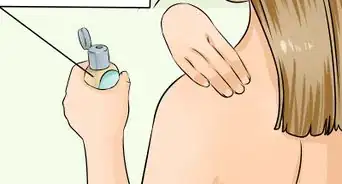This article was co-authored by Margareth Pierre-Louis, MD. Dr. Margareth Pierre-Louis is a board certified Dermatologist and Dermatopathologist, Physician Entrepreneur, and the Founder of Twin Cities Dermatology Center and Equation Skin Care in Minneapolis, Minnesota. Twin Cities Dermatology Center is a comprehensive dermatology clinic treating patients of all ages through clinical dermatology, cosmetic dermatology, and telemedicine. Equation Skin Care was created to provide the best in evidence-based, natural skin care products. Dr. Pierre-Louis earned a BS in Biology and an MBA from Duke University, an MD from the University of North Carolina at Chapel Hill, completed a residency in dermatology at the University of Minnesota, and completed a dermatopathology fellowship at Washington University in St Louis. Dr. Pierre-Louis is board certified in dermatology, cutaneous surgery, and dermatopathology by the American Boards of Dermatology and Pathology.
There are 19 references cited in this article, which can be found at the bottom of the page.
This article has been viewed 198,629 times.
People of all skin tones may want to increase their melanin levels for a variety of reasons – to get a summery golden glow, to counteract uneven skin pigmentation, or to combat a skin condition. While laying out under the sun or inside a tanning bed are the fastest ways to deepen the skin tone, increases in melanin production technically signify skin damage. Tanning should be done responsibly and gradually to reduce the amount of long-term damage. The addition of certain vitamin-rich foods to your diet will leave you looking (and eating) healthier than ever. In consultation with your doctor, you can also choose from a variety of melanin-boosting supplements or treatments.
Steps
Tanning under UV Exposure
-
1Lay out under natural sunlight to develop a tan. To develop an even, all-over suntan, first apply sunscreen with a minimum SPF of 15 (SPF 30 or more is a safer choice). Lay out on your back under direct sunlight with your skin exposed. After about 20 or 30 minutes, flip over to your belly. Another 20 or 30 minutes later, cover up your skin and get out of the sun.
- Most sunscreens take a while to soak into your skin and start working, so wait 20 minutes after applying sunscreen before going outside.[1]
- Repeat this process a couple of times per week and you’ll start to notice your skin tone gradually deepening.
- Skin cells produce melanin as a way of protecting their DNA from UV damage. As you’ve probably noticed in sunnier seasons, exposing your skin to more UV radiation spurs on the production of melanin and your skin gets darker.[2]
-
2Avoid getting sunburned at all costs. When your skin takes in more UV radiation than it can handle, you’re left with thermal burns and blood flow increases to that area, leaving your skin red and irritated.[3] Sunburns damage your skin cells and halt melanin production. Don’t overdo your sun exposure. Instead, limit yourself to 1 hour per day. Give your skin time to rest away from the sun’s UV rays between tanning sessions.
- Don’t attempt to get a serious sunburn to “start” your tan. This habit is a myth and will slow your progress toward a gradual tan.
- Sunburned skin can develop skin cancer and early signs of aging.[4]
- Remember that since melanin production is a sign of skin cell damage, there’s not a “safe” way to get a suntan.
Advertisement -
3Wear sunscreen every day and reapply it regularly.[5] Apply sunscreen with an SPF of 15 or more to all exposed areas of skin. This includes easy-to-forget areas like your feet, ears, and scalp. Lather on more sunscreen than you think you should – 1 fluid ounce (30 mL) of sunscreen should effectively cover your body. Reapply sunscreen once every 2 hours, and immediately after your skin gets wet.[6]
- Sunscreen doesn’t stop you from tanning, but it will help protect you from burning.
-
4Hydrate your skin by drinking lots of water every day. Healthy, hydrated, and supple skin cells are more likely to maintain an even tone and repair themselves from UV damage. If you’re not in the habit of hydrating yet, carry around a water bottle and gradually increase your consumption from 1 bottle to 5 or more.
- Drinking plenty of water will prevent you from becoming hydrated. Dehydration plus overexposure to the sun can lead you to feel very ill. You won’t be worrying about your tan if you get rushed into the emergency room for an IV drip.[7]
-
5Spend time in a tanning bed to increase UV exposure. Book an appointment at a tanning salon and select either a horizontal or vertical tanning bed. While you’re in the bed, wear protective goggles and a bathing suit. Rotate your body to achieve an even tan. Start out with short sessions of 5 to 7 minutes. In consultation with a salon technician, gradually increase your sessions once you have a deeper skin tone.[8]
- The use of tanning beds is strongly discouraged by dermatologists and doctors since they can cause skin cancer. Technically, though, they do emit UV rays that will encourage melanin production and darken your skin tone over time.[9]
Eating Vitamin-Rich Foods
-
1Consume foods with high levels of beta-carotene and Vitamin A. Add orange and red vegetables like carrots, tomatoes, sweet potatoes, acorn squash, and red bell peppers to your diet, along with fruits like pumpkins, papayas, and cantaloupe.[10] While beta-carotene doesn’t technically spur on melanin production, this fat-soluble pigment will accumulate in your skin to give you a natural golden glow.[11] The effects of beta-carotene on skin pigmentation have been found most effective on lighter skin tones.[12]
- Many of these foods also contain Vitamin A, an antioxidant that helps support the production of melanin.
- Mix dark green vegetables like broccoli, spinach, and some lettuce varieties into your diet. Despite their color, these foods also contain beta-carotene.[13]
- Cooking these vegetables won’t decrease the amount of beta-carotene you ingest, so feel free to get creative in the kitchen.[14]
-
2Eat foods containing Vitamins C and E. Vitamin E can be found in nuts, whole grains, seeds, and many fruits and vegetables including asparagus, avocados, and corn. You can get Vitamin C from citrus fruits (such as oranges, grapefruit, and clementines) as well as pineapples and bell peppers. Foods rich in both vitamins include green leafy vegetables, tomatoes, berries, and broccoli.[15]
- These foods have antioxidant properties, meaning they can help protect your skin from cell damage while encouraging balanced melanin production.[16]
- To get the highest vitamin levels from fruits and vegetables, eat them raw.
-
3Add oil-rich fish to your diet to boost your Vitamin D intake. Increased melanin production reduces the skin’s ability to take in Vitamin D from natural sunlight exposure. It’s a crucial vitamin for keeping the bones and blood healthy, so you should supplement your diet with a few of the foods that contain the vitamin. Incorporate fish like salmon, catfish, mackerel, and herring into your diet. Canned fish like tuna and sardines are good sources as well, as are fish oils including cod liver oil.[17]
- Use moderation and eat these foods a few times a week to reduce your overall consumption of fat and mercury.
Undergoing Treatments and Taking Supplements
-
1Take vitamin supplements to combat vitamin deficiencies. Beyond incorporating vitamin-rich foods to your diet, you can boost your levels of Vitamins A, C, D, or E through supplements. Beta-carotene supplements are available without a prescription, but are typically used to treat skin conditions.[18]
- Work beta-carotene-rich foods into your diet before turning to supplements.
- Consult your doctor to see which, if any, supplements are right for you.
-
2Consider melanin pills and PUVA therapy to treat serious skin conditions. Speak with your doctor about this process if you’re looking to treat vitiligo, eczema, psoriasis, or another condition. You may be prescribed a 10 mg (0.00035 oz) melanin tablet to take orally. This is followed by a photochemotherapy treatment involving exposure to UV light.[19]
- Alternatively, the tablet can be dissolved in a bath and taken topically.
-
3Take synthetic melanin hormone injections to darken your skin. The synthetic peptide hormone Melanotan II will speed up the body’s production of melanin. This results in a darker skin tone without any UV exposure. In consultation with your doctor, acquire the product legally with a prescription. You can use a sterile 27 gauge 1 mL (0.034 fl oz) needle to inject a dose (0.025 mg (8.8×10−7 oz) of the hormone per 1 kg (2.2 lb) of body weight) into your abdominal folds. Repeat this process on a weekly basis until you reach your desired skin tone.
- Note that Melanotan-II is not FDA approved.[20] It is typically sold online. However, sale and consumption are banned in the U.S., Europe, and Australia.[21]
- Dermatologists warn against taking these injections due to the unknown long-term effects.[22]
- Melanotan II was designed as an erectile dysfunction treatment. Be aware of the hormone’s ED-related effects.[23]
Expert Q&A
Did you know you can get expert answers for this article?
Unlock expert answers by supporting wikiHow
-
QuestionHow often should I reapply sunscreen?
 Margareth Pierre-Louis, MDDr. Margareth Pierre-Louis is a board certified Dermatologist and Dermatopathologist, Physician Entrepreneur, and the Founder of Twin Cities Dermatology Center and Equation Skin Care in Minneapolis, Minnesota. Twin Cities Dermatology Center is a comprehensive dermatology clinic treating patients of all ages through clinical dermatology, cosmetic dermatology, and telemedicine. Equation Skin Care was created to provide the best in evidence-based, natural skin care products. Dr. Pierre-Louis earned a BS in Biology and an MBA from Duke University, an MD from the University of North Carolina at Chapel Hill, completed a residency in dermatology at the University of Minnesota, and completed a dermatopathology fellowship at Washington University in St Louis. Dr. Pierre-Louis is board certified in dermatology, cutaneous surgery, and dermatopathology by the American Boards of Dermatology and Pathology.
Margareth Pierre-Louis, MDDr. Margareth Pierre-Louis is a board certified Dermatologist and Dermatopathologist, Physician Entrepreneur, and the Founder of Twin Cities Dermatology Center and Equation Skin Care in Minneapolis, Minnesota. Twin Cities Dermatology Center is a comprehensive dermatology clinic treating patients of all ages through clinical dermatology, cosmetic dermatology, and telemedicine. Equation Skin Care was created to provide the best in evidence-based, natural skin care products. Dr. Pierre-Louis earned a BS in Biology and an MBA from Duke University, an MD from the University of North Carolina at Chapel Hill, completed a residency in dermatology at the University of Minnesota, and completed a dermatopathology fellowship at Washington University in St Louis. Dr. Pierre-Louis is board certified in dermatology, cutaneous surgery, and dermatopathology by the American Boards of Dermatology and Pathology.
Board Certified Dermatologist
Warnings
- Many so-called “tanning pills” on the market contain unnaturally high levels of the color additive canthaxanthin. Be aware that these products are not FDA approved. Their side effects may include retina damage.[24]⧼thumbs_response⧽
- The idea that more melanin or a deeper tan will protect your skin from UV radiation is a myth. Tanned skin produces a Sun Protection Factor (SPF) of less than 4. The minimum recommended level of coverage is SPF 15.[25]⧼thumbs_response⧽
References
- ↑ Margareth Pierre-Louis, MD. Board Certified Dermatologist. Expert Interview. 15 May 2020.
- ↑ https://lpi.oregonstate.edu/mic/health-disease/skin-health
- ↑ https://www.fda.gov/radiation-emittingproducts/radiationemittingproductsandprocedures/tanning/ucm116432.htm
- ↑ Margareth Pierre-Louis, MD. Board Certified Dermatologist. Expert Interview. 15 May 2020.
- ↑ Margareth Pierre-Louis, MD. Board Certified Dermatologist. Expert Interview. 15 May 2020.
- ↑ Margareth Pierre-Louis, MD. Board Certified Dermatologist. Expert Interview. 15 May 2020.
- ↑ https://www.vogue.it/en/beauty-look/skin-care/2018/06/25/how-to-get-the-best-tan-faster-andsafely-this-summer/?refresh_ce=
- ↑ https://www.lighttherapydevice.com/the-ultimate-tanning-bed-guide/
- ↑ https://www.ncbi.nlm.nih.gov/pmc/articles/PMC2692214/
- ↑ https://www.healthline.com/health/how-to-increase-melanin#tips
- ↑ https://www.medicalnewstoday.com/articles/252758.php
- ↑ https://academic.oup.com/jn/article/132/3/399/4687282
- ↑ https://www.mayoclinic.org/drugs-supplements/beta-carotene-oral-route/description/drg-20066795
- ↑ https://www.mayoclinic.org/drugs-supplements/beta-carotene-oral-route/description/drg-20066795
- ↑ https://www.eatright.org/food/vitamins-and-supplements/types-of-vitamins-and-nutrients/antioxidants-protecting-healthy-cells
- ↑ https://www.hindawi.com/journals/omcl/2014/860479/
- ↑ https://www.ncbi.nlm.nih.gov/pmc/articles/PMC3356951/
- ↑ https://www.mayoclinic.org/drugs-supplements/beta-carotene-oral-route/description/drg-20066795
- ↑ https://www.nhs.uk/conditions/vitiligo/treatment/
- ↑ https://www.fda.gov/RegulatoryInformation/FOI/ElectronicReadingRoom/ucm521054.htm
- ↑ https://www.addiction-ssa.org/commentary/using-the-internet-to-track-the-purchase-of-illicit-drugs-melanotan-ii
- ↑ http://www.abc.net.au/local/stories/2015/01/27/4168954.htm
- ↑ http://www.penington.org.au/anexbulletin/the-dark-side-of-tanning-injections/
- ↑ https://www.fda.gov/cosmetics/productsingredients/products/ucm134217.htm
- ↑ https://www.fda.gov/radiation-emittingproducts/radiationemittingproductsandprocedures/tanning/ucm116432.htm
About This Article
If you want to increase melanin production without damaging your skin, make sure to tan responsibly and adjust your diet to include vitamin-rich foods. When you lay outside to tan, always apply a sunscreen with a minimum SPF of 15 and only stay out in the sun for an hour at most. By taking these precautions, you can avoid getting a sunburn, which will damage your skin cells and reduce melanin production. As you tan, keep yourself hydrated throughout the day to maintain an even skin tone and avoid dehydration. In addition to tanning, eat foods high in beta-carotene and vitamin A, like carrots, tomatoes, and sweet potatoes. While these foods won’t increase melanin production, they’ll help give your skin a natural glow. For more help, like how to safely take supplements that darken skin, scroll down.
